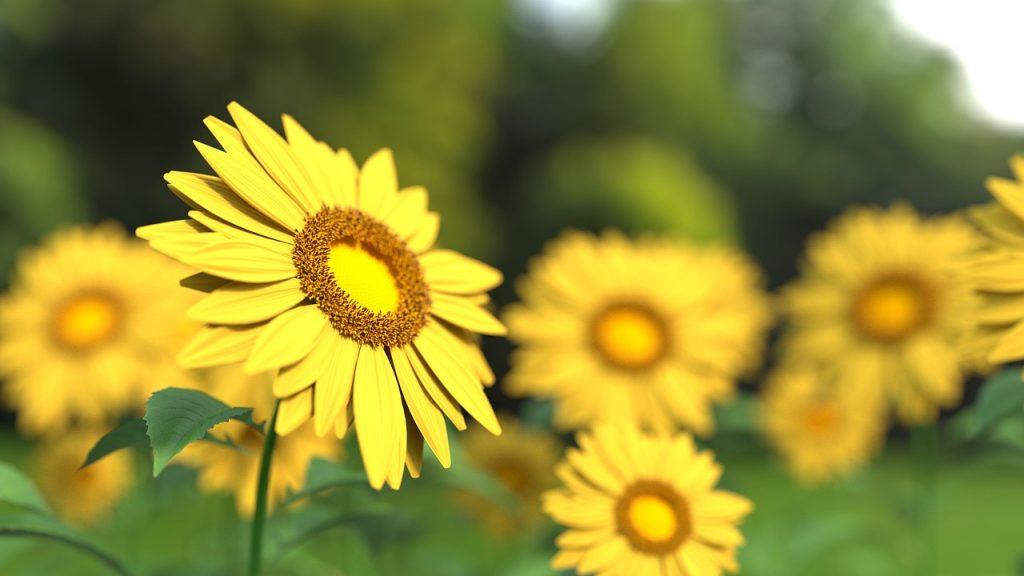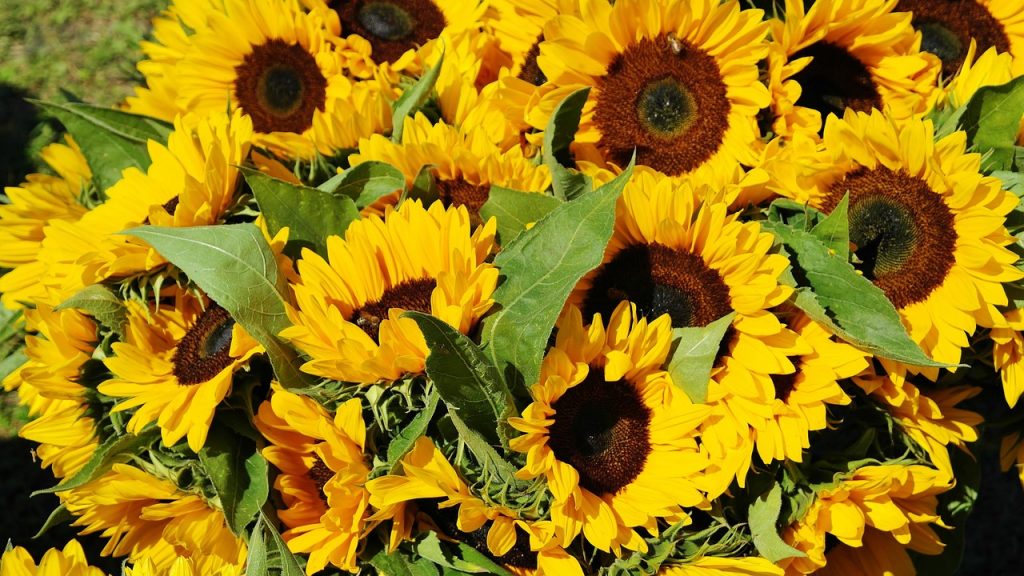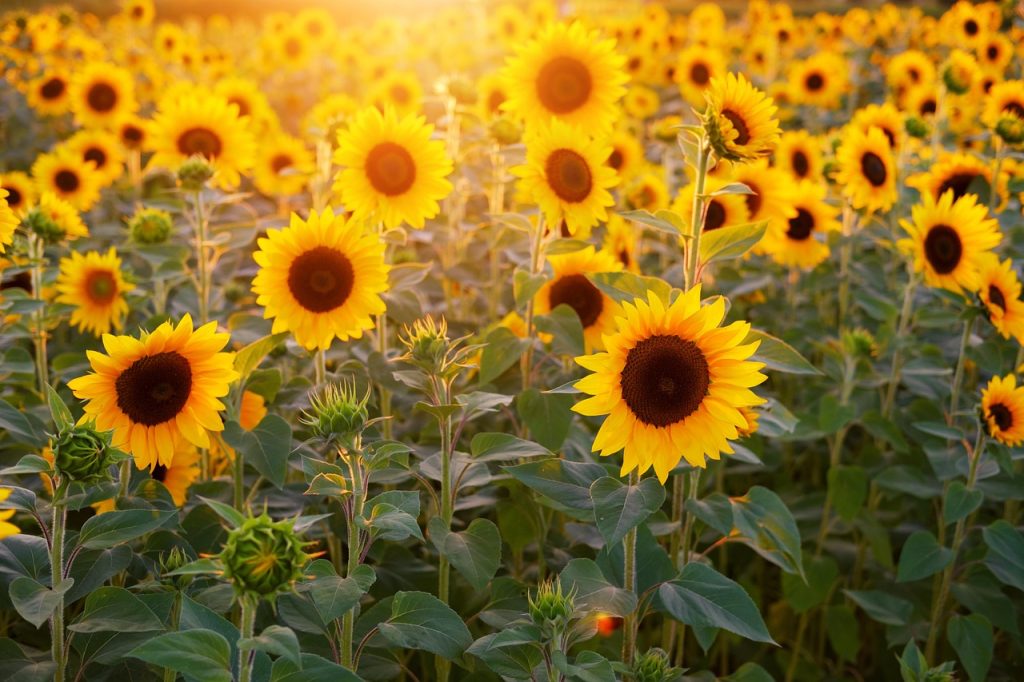Sunflowers are more than just vibrant, towering blooms that brighten up gardens and fields. These striking plants, known for their large, daisy-like flower faces, have captivated gardeners and plant enthusiasts for centuries. Besides their aesthetic appeal, World of sunflowers are renowned for their usefulness, ranging from edible seeds to oil production. Let’s delve into the captivating world of sunflowers, exploring their origin, growth habits, ideal growing conditions, and practical applications in everyday life.

The Origins and Characteristics of Sunflowers
Sunflowers (Helianthus annuus) are native to North America, where they were domesticated around 1000 B.C. by Native Americans. These plants were initially cultivated for food, medicinal purposes, and even as a dye source. The sunflower’s name is derived from its behavior of turning to face the sun, a phenomenon known as heliotropism, which is most prevalent in young blooms.
Appearance and Varieties
Sunflowers are characterized by their large, round flower heads and bright yellow petals, often with a contrasting dark center. While the classic towering sunflower can reach heights of up to 12 feet, there are numerous varieties to explore:
- Dwarf Sunflowers: Perfect for smaller gardens, these varieties grow only a few feet tall.
- Giant Sunflowers: Known for their impressive height, some can exceed 15 feet.
- Colored Sunflowers: Varieties like ‘Moulin Rouge’ and ‘Chianti’ offer unique red and burgundy shades.
Optimal Growing Conditions for Sunflowers
To cultivate healthy World of sunflowers, understanding their environmental needs is crucial. These plants thrive under specific conditions that mimic their native habitat.
Sunlight and Temperature
Sunflowers are sun-loving plants, requiring full sun for at least 6-8 hours a day. They prefer warm climates and can tolerate a wide range of temperatures but flourish in conditions between 70°F and 78°F. While young plants exhibit heliotropism, mature sunflowers usually face east to catch the morning sun.
Soil and Watering Needs
Sunflowers are not particularly fussy about soil but perform best in well-draining, nutrient-rich soil. Although they can tolerate dry conditions, regular watering is essential during their growth phase. Over-watering should be avoided to prevent root rot. A general rule is to water deeply once a week.
Planting and Propagation Techniques
World of sunflowers can be a rewarding experience, especially when you see them towering over your garden. Here’s how to plant and propagate these stunning blooms effectively.

Starting from Seeds
Sunflowers are most commonly propagated from seeds, which should be sown directly into the soil after the last frost. Plant seeds 1 inch deep and 6 inches apart, thinning them to 12 inches as they grow. For continuous blooms, sow seeds every two weeks through early summer.
Transplanting Seedlings
While direct sowing is preferred, sunflowers can also be started indoors and transplanted. If opting for this method, ensure seedlings are hardened off before moving them outdoors to prevent transplant shock.
Seasonal Care and Maintenance
World of Sunflowers require minimal maintenance, but a few seasonal care tips can help ensure a healthy and bountiful display.
Fertilization and Mulching
Applying a balanced fertilizer in the early growth stages can boost growth, especially in nutrient-poor soil. Mulching around the base helps retain moisture and suppress weeds, providing a healthier growing environment.
Pest and Disease Management
Common pests include aphids and caterpillars, which can be managed using insecticidal soap or natural predators like ladybugs. Fungal diseases such as powdery mildew can be mitigated by ensuring proper air circulation and avoiding overhead watering.
Sunflowers’ Practical Applications
Beyond their beauty, sunflowers offer several practical uses that make them valuable additions to any garden.
Edible Seeds and Oil Production
Sunflower seeds are a popular snack, rich in nutrients like vitamin E and magnesium. The seeds are also pressed to produce sunflower oil, a healthy cooking oil known for its light taste and high smoke point.
Wildlife Attraction
Sunflowers attract a variety of wildlife, including bees, birds, and butterflies, making them excellent for promoting biodiversity in gardens. The seeds provide a food source for birds, particularly during the fall and winter months.
Environmental Benefits
World of Sunflowers are used in phytoremediation projects to absorb toxins from soil, showcasing their ability to improve environmental health. Their deep roots also help reduce soil erosion.

Frequently Asked Questions About Sunflowers
Sunflowers typically take 70 to 100 days from planting to bloom, depending on the variety and growing conditions.
Yes, dwarf sunflower varieties can be successfully grown in pots as long as they receive adequate sunlight and are planted in a well-draining potting mix.
Yellowing leaves can indicate over-watering, nutrient deficiencies, or disease. Ensure proper watering, check soil nutrient levels, and inspect for pests or diseases.
Sunflowers are annuals, meaning they complete their life cycle in one season. However, they readily self-seed, and new plants can emerge the following year if seeds are left to fall naturally.